Geographical Cultural Ethos → science is dead (Part 2)
Click here to read Part 1. Part 2 continues below…
Economic Evolution Selects for Defection Fitness
The genius Freeman Dyson pointed out that exponentially faster paradigms of evolution (i.e. other than competing species, thus including cultural adaptation and futuristic self-engineered genetics), are the relevant evolutionary model after the expired Darwinian interlude.
The aforementioned Asian model of solidarity via social hierarchy requoted below wasn’t an optimal fit in the less isolated and more dynamic geopolitical, geographical situation of Europe:
This squelching of defection into a pseudo-homeostasis within the nation, fostered economic development that expanded the pie for all clans. Additionally it enhanced resistance to external threats by subsuming the invasion strategy of divide-and-conquer alliances with clans against other clans.
To maximize economic development, Western European civilization required both the bottom-up flexibility to adapt to inherently greater instability that a rigid top-down social hierarchy wouldn’t allow, and sufficient top-down internal cohesion/cooperation to resist said instability, such as by forming alliances to counteract external geopolitical threats. Defection due tribal and clan conflict was economically deselected by the aforementioned implicit non-species evolution, because alliances and paradigms of cooperation facilitated greater economic development via increased stability, road infrastructure, capital investment, and trade. Yet for the reasons stated, this development couldn’t evolve in the European context from a rigid top-down social hierarchy.
This became manifest for example in the economic development under the Roman Republic form of democracy as the plebeians challenged the exclusive political control of the aristocratic patricians. This constitutional evolution of the Conflict of the Orders was essentially a means of rewarding the individual achievement of newly wealthy plebeians so they could participate in the said control. This opening of opportunity and “no taxation without representation” became the model for the constitutional evolution in the United States republic wherein initially the landless, females, and slaves couldn’t vote. Yet all forms of democracy become unstable due to destruction of capital when enabling control by the mob of underachievers in an egalitarian direct form of democracy such as in Athens (aka socialism).
European social organization had to evolve such that top-down control could squelch defection by clannism, yet not become ossified in the “thousand years plan” maladaptive, insulated social hierarchy of Asia. This maladaption for example eventually forced China into psychologically irresistible, ressentiment-based Communism (while temporary “rejecting” the more rational Confucianism) in order to extract the nation out of the agricultural age and solve its problem of exploding population and stagnant economic growth problem, (by killing and death by starvation of 65 million Chinese). Communism in China seems to have been the means to overcome the ossification of Confucian reverence for non-changing social order, filial piety, and utmost respect for the past.
Neither Asians nor Europeans en masse were willingly going to consciously abandon their clan and tribal prejudices.
In both cases, subconscious ressentiment was the only way to trick or motivate the people into horizontal (i.e. not clan-based) cooperative political organization which was deleterious to their clannism. Whereas, China could retain the clans integrated with conscious social hierarchy of Confucianism for insular, maladaptive epochs, but required ressentiment-based subversion (of those ossified vested interests inertia) when radical change became economically necessarily. Conversely, adaptation within Europe’s dynamic environment required continuous subconscious subversion of clannism via ressentiment. Tangentially, a plausible reason why Westerners deny and Asian embrace a realistic cyclical interpretation of reality might be the realism of the highly observant Asians versus the continuous illusions harbored by the Western ressentiment-based idealism. Specifically the social justice delusion of a monotonically (aka “linear”) increasing improvement of humankind. The conscious, righteous ideal of stewardship isn’t mass adopted because subconscious ressentiment is more seductive. The Bible tells the righteous stewards, “you do not belong to the world, but I have chosen you.”
In Europe, democracy and Christianity supplied the evidently massive demand for ressentiment. Even the etymology of the word Ecclesia derived from the word ecclesia, which was the voting assembly in the direct democracy (aka socialism) of Athens. In Christianity, Ecclesia (or ‘Church’) is the whole set of all the faithful. Christianity and demand for social justice in the form of democracy was spreading virally by “spiritually” placating the ressentiment of the people w.r.t. the insoluble problem of unequal distribution of wealth and the corruption it begat. The grievances were real, but the solace was illusory (except for its beneficial higher-order effects on defection of clans thus enabling wider cooperation). This was evident in the appearance of the Book of Revelation around that time:
Because they were convinced that the work of the Messiah must end in triumph and glory, they believed that this end could be accomplished only by a return of Jesus back to this earth from the heaven to which he had ascended […]
As time passed, many Christians — especially those who were suffering persecution at the hands of the Roman government — became deeply concerned about how long it would be before these events would take place […]
Under these conditions, a Christian named John wrote Revelation […] The purpose of the book was to strengthen the faith of the members of these churches by giving to them the assurance that deliverance from the evil powers arrayed against them was close at hand […]
Christ commends those churches whose members have endured persecution and, in some instances, even death rather than declare their allegiance to Roman rulers, who proclaimed their own divinity and demanded that they should be worshipped along with the other gods of the empire. He refers to Pergamum as Satan's home inasmuch as it was in this place that the cult of emperor worship was particularly strong.
Christ warns Christians to expect that their persecutions will be even more severe in the immediate future. Nevertheless, they are to remain faithful and regard these afflictions as tests of their character. Those who remain loyal will be delivered from the hands of their enemies, and in the new order of things soon to be established […]
The unique feature about Revelation is the particular occasion that caused it to be written. Toward the end of the first century of the Christian era, the attitude of the Roman government toward Christianity became especially hostile. Nero, the Roman emperor, charged that Christians were to blame for the burning of Rome. Although the charge was false, it was sufficient to cause many people to regard the new Christian movement with suspicion. Jews and Romans alike resented the fact that Christians condemned so many of the things they were doing, and they especially disliked the belief on the part of Christians that their religion was superior to the older faiths that had been honored for centuries. The Christians often held their meetings in secret places, and their critics imagined that they were doing all sorts of evil things. It was easy to circulate rumors of this kind, and along with other things, Christians were charged with plotting against the Roman government. As the opposition to Christianity became more intense, the followers of the new movement were asked to prove their loyalty to the Roman government by denouncing Christ and by worshipping the statue of the emperor. When they refused to do this, they were tortured and even put to death.
Under these conditions, the Revelation of John was written. It would be difficult to imagine anything more appropriate for the members of Christian churches at that time. They needed encouragement and the assurance that their trials would soon be over, that the evil powers of the earth would be destroyed, and that the triumph of righteousness would be established in the world. The message of Revelation was intended for this particular time and set of circumstances.
Due to the viral spread of this phenomenon, the Roman Empire was forced to embrace Christianity circa 311 AD in the Edict of Milan. And by 380 AD it became the official state religion.
In addition to the positive impacts on cooperation via ressentiment masked as “spiritual” idealism with hope for improving social justice, the Western branch of the schism (i.e. the Roman Catholics) had instituted stricter morality than in the Eastern church. Remember from the prior section that Eastern Europe and Russia are in between the geographically driven cultural ethos of Western Europe and East Asia in that idealism couldn’t entirely dominate patronage and clannism. It’s not a panacea that Westerners are the most ideologically (as in delusional opposed to reality) based. The core of the Roman Empire didn’t end. The Holy Roman Empire in Western Europe continued until 1806. The stricter Western Roman (Catholic/Puritan) morality rot reached a defining moment in 1801 when laws on enforcing morality on married women were vacated by the high priests of idealism, ressentiment, and social justice. This marked the collapse of the rule of law, as for example dysfunctional family law (c.f. also) and society would increasingly turn against wealth and (especially white) men, and towards the dysfunctional outcome of the non-righteous ressentiment-based idealism in the forms of social justice and direct democracy.
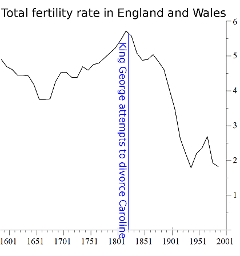
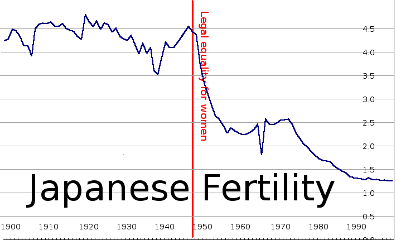
Yet for more than a thousand years prior, the morality had a significant, beneficial impact on minimizing the defection of clannism.
The idealism of truthfulness and honest work fostered science:
You will notice that these features of Christianity support a world where truth is spoken, promises are kept, and science is actually scientific. Which is a big part of why it was Christians that made the scientific and Industrial Revolutions, not Jews and not Muslims, why it will be Christians that settle space and conquer the universe.
Tangentially it’s not surprising that the Pope[False Prophet] and many in the Catholic church have turned further towards extreme social justice. Ressentiment was always their fulcrum and there’s no political capital on the righteous side of idealism. For laughs I may have a numerological stake in this.
But Western atheism can’t survive long-term because it’s negentropic (i.e. normal distributions should be bell curves not U-shaped):
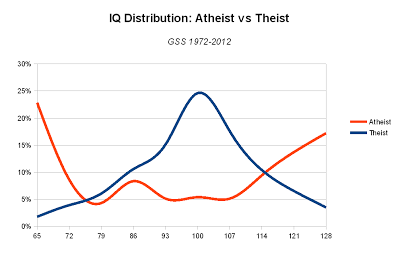
IQ distribution of atheists in the U.S.A.
Yet the religion that rises might not be Christian because Islam in the West is reproducing faster than the native Westerners. Or if somehow the West merges with the Chinese who are predominantly atheist.
Hajnal line and manorialism
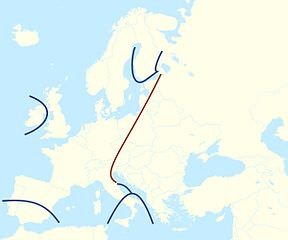
Western Roman Catholicism enforced a ban against cousin marriages which discouraged clan bequests and encouraged neolocal households.

Manorial system
The Hajnal line (aka Western European marriage pattern) was likely significantly the result of the aforementioned familial system which was symbiotically interlinked with manorialism forming a geographical distinct culture and economy for Western Europe:
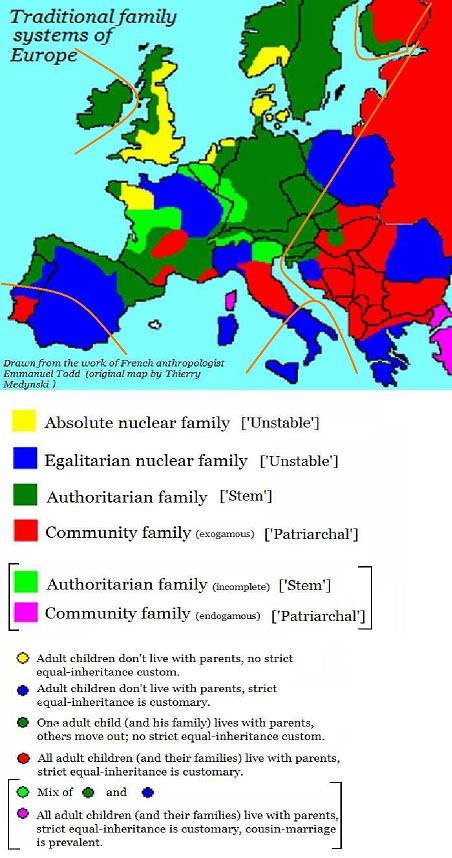
Traditional family systems of Europe
This weakened paternalism and diluted clannism defection in favor of the power of the Catholic church (which stepped into the power vacuum created by the rapid spread of Christianity that reduced the divine right mandate of emperors) and its alliances with kings, which fostered economic growth and military alliance. Some of the effects on the gender roles in relationships remains until present day.
The neolocal and non-paternalistic bequests pattern forced young men and women into the workplace instead of being nurtured collectively by the patrilineal clan (extended family) as in cultures east of the Hajnal line. An oversupply of labor driving wages down and suffering and technological stagnation up, resulted from the booming agricultural output due to the aforementioned economic development and global warming (c.f. chart in Part 1). This medieval dilemma was rectified by the culling of 50% of Europe’s population by the Black Death. This resulted in an undersupply of (especially farm) labor which provided the impetus for the Agricultural Revolution employing improved technology/breeding and subsequently the Industrial Revolution.
The Industrial Revolution was due to network effects of the former including its impacts on maximizing the division-of-labor. The impacts weren’t as prevalent in the East and especially not in East Asia. Nick Szabo explained that due to the population explosion of patrilineal clannism, the East was forced to dedicate so much of their arable land to crops for feeding humans instead of pasture for feeding horses that their relative transportation costs increased exponentially. This caused the division-of-labor to regress in the East, for example to human porters instead of horses in East Asia! The Victorian era Internet in Western Europe even had a physical-transport communication network analogous to the electromagnetic-transport modern Internet.

China and the Chinese, 1920s

I previously thought communal production of rice which requires local politics for aqueducts contrasted to wheat production which requires only rainfall might be a factor in the adoption of social hierarchy versus individualism. Combined with Nick Szabo’s research, I conclude that rice growing regions were less pastoral thus relying more on low tech human labor thus retarding the forward advance of the division-of-labor.
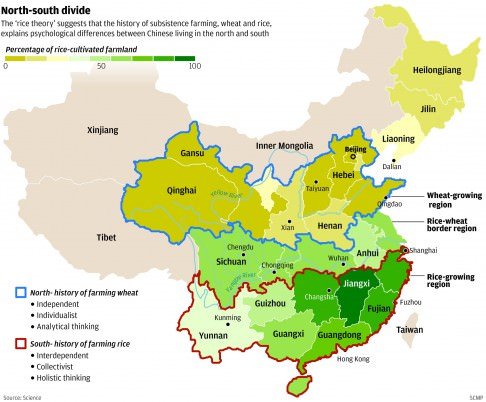
Why China's wheat-growing north produces individualists and its rice-growing south is clannish

Initially coming out of the Black Death, the age component of the marriage pattern temporarily adjusted downward to fit the undersupply of labor but reverted as the holistic impacts of destroying patrilineal clans combined with proliferation of ressentiment-based idealism such as social justice, socialism, and its more perverse derivative effects (e.g. propaganda manipulations of the Zionist elite) manifestations such as feminism.
The rule-of-law in the West seems to be based significantly on universal Holy Roman canon. This is consistent with the Hajnal line dilution/dissolution of clannism and the rise of the ressentiment-based idealism’s demand for absolute (man-subjugates-nature, monotonically improving state of humankind) dictates and perfected social justice. Reaching glorious heights of War on Terror, War on Human Trafficking, War on Teenage Pregnancy, War on Carbon, War on War, War on Urinating in a Standing Position, War on Wars on War, Legalization of War on Marijuana, War on Legalization of War on Marijuana, and so on. For example, Romans 13:1–7 assures the flock, “Let everyone be subject to the governing authorities, for there is no authority except that which God has established.” Whereas in the East, there’s no fixed system of laws. We may even say the Russians loved their vodka more than the idealism of Christianity or Communism! Instead there’s opaque custom, connections, favoritism, and other mechanisms for negotiating patronism’s social hierarchies. Thus not present in the East were the Western economies-of-scale for protection of intellectual property and other economic benefits of the rule-of-law such as limited liability corporations:
We are vastly wiser than our ancestors in matters of technology, and the biggest break through was the limited liability company and double entry accounting. While the limited liability company is a disaster for banking and insurance, because of the obvious moral hazard, which results in banking and insurance companies becoming quasi govermental, becoming defacto socialist, the limited liability company and double entry accounting made possible Rand’s heroic scientist engineer ceo, who mobilizes other people’s capital and organizes other people’s labor to advance technology, and make those improvements in technology widely available. We first see technological advance mediated by limited liability companies, we first see Rand’s hero scientist engineer CEO, immediately after the restoration of Charles the Second.
The following civic participation chart highlights the increased teamwork cooperation of Westerners outside of their clan. Is India’s high level of teamwork due to British influence or indigenous?
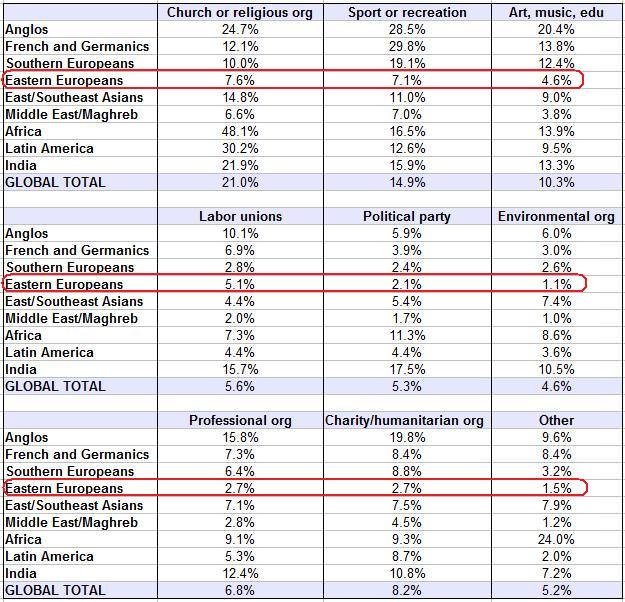
The outbreeding was perhaps “most extreme” in the USA:
whites — especially in places like the united states — are so outbred that they don’t have strong enough ethnocentric sentiments to protect themselves from “invasions” by outside groups.
Overcoming the Power-law Distribution
I posit humans will bypass the power-law distribution (to remove it as a justification for ressentiment), by moving from a fungible resource-limited (i.e. bounded, tragedy-of-the-commons) perspective of our reality, to a decentralized information (interaction and curation) model that is an inverse commons of unbounded perspectives of information. For example a geographical bound on commerce is being ameliorated by global cryptocurrency.
Measurable, fungible existence invariably leads to highly concentrated, power-law distributions (1, 2, 3, 4, 5, 6, 7) of fungible resources, of fungible metrics of intelligence (e.g. g factor) which are inherently incomplete and negentropic, of fungible measures of achievement, and concentrations of any other fungible concurrence. Fungibility (by definition of ubiquitous thus total and not partial) is inherently maladaptive, negentropic, and not directed towards the maximum division-of-labor, because of a total order can’t exist in our universe. Let’s remember that in thermodynamics the inexorable trend to maximum entropy is a trend to maximum uncertainty (aka maximum probabilistic degrees-of-freedom); and fungible metrics presume there’s a trend to less uncertainty.
To the extent that humans-at-large measure their happiness and worth of their existence in fungible units (and not in “righteousness”?), I explained that these power-law distributions necessitate placating ressentiment-based psychology for groupwise adaptation and development. Thus I posit an intangible information-based future where these power-law concentrations will diminish overall because of the highly non-fungible nature of information. Although such concentrations will perhaps still be present within any particular set of shared perspectives of information and even the scale-free network4 links between sets of shared perspectives, the distribution across all such sets should be Gaussian (i.e. entropic) instead of power-law because there’s no fungible relation between them. Fungibility as an optimal-routing problem is the generative essence of power-law distribution. (Perhaps in a future blog, I will be have some time to develop some math support for this intuition)
Information is inherently relativistic and non-fungible. Information content is only bounded in a dimensional perspective such as gravity (by the bounded number of dimensions) as I explained:
Relating Physics to Information
What I want to add is the insight that gravity emerges from the probability that the microstates of relative bodies of mass can't avoid dispersing some energy from the one with the higher energy (mass) to the one with less. As the bodies move closer to each other, the equations dictate the force increases, and this is because the number of equiprobable microstates is decreasing as the surface area of the imaginary sphere decreases, so relative acceleration between the two bodies must increase so as to maintain the rate of energy dispersion. Or in other words, as the bodies move closer to each other, the change in the relative entropies decreases, so the acceleration (and force) increase to compensate since the relative energy (mass) has not changed.
So the upper bound for information content (Shannon entropy) of that system of two relative bodies is directly involved in physics of the acceleration of relative bodies due to the gravitational force. So intangible information content which is a dimensionless quantity, is projected into a dimensional structure in the physical world and thus interacts with energy and forces. This is profound because it seems to hint that information content is not orthogonal to our physical world.
As humans increasingly transition to valuing the unbounded assimilation and interaction of information, i.e. as we approach Rifkin Zero Marginal Cost Society 4 (atoms are heavy but not infinitely so!), economic focus shifts from resource-extraction (bounded) tragedy-of-the-commons to unbounded (inputs of information) inverse commons.
Although we could argue that intangible information and fungible resources are both theoretically unbounded if (opportunity) cost (of their access, availability, and production) is not a factor, the key distinction is that intangible information can’t be monopolized!
Cathedral-style closed source doesn’t scale because it’s centralized and negentropic (e.g. it isn’t maximally efficient nor resilient). Intangible information can’t be power-law distribution dominated. Bottom-up (i.e. decentralized) processes have a normal maximally entropic distribution (i.e. Gaussian distribution) not power-law nor any other form of negentropic. Thus, humans live in a top-down, fungible spacetime jail only in their own minds and thus their own choosing. Intangible information subsumes spacetime as I will explain further below. Friction is retained because information can’t be totally consistent, i.e. it can’t be a total order and thus not all observers will agree. Yet this diversity is not negentropic. The friction is necessary so our existence doesn’t melt away (in a heat death) into a featureless ether of infinite entropy; and it’s analogous to the fact that due to the limitation of the speed-of-light, electromagnetic-transport based latency doesn’t scale exponentially as bandwidth does. (Though “spooky action at a distance” quantum entanglement may eventually provide a breakthrough for scaling latency, but only if there’s no universal decoherence so state changes don’t have to propagate consistently to every possible future observer)
Relate what I wrote in 2014:
Moreover the non-monetary square law scaling of the Inverse Commons applies in that participants gain the return of the creations and incremental improvements of their brethren. It is a mesh topology N-highway of sharing. My belief is that according to gift culture Eric outlined, the community is aligned towards acknowledging sources especially when the act of doing so is only an insignificant (automated) micro payment or other remuneration models the ingenious may develop. Insignificant micro payments then aggregate to the creators at the rate of the participants squared. The squared law seems to be so powerful and at the heart of why the Inverse Commons is the “only known positive scaling law of software engineering” as so eloquently and astutely noted by Eric. That audio of Eric is permanently imprinted in my primary consciousness. I can never forget random “monkeys beating on the code” can outperform the cathedral of closed source (which I want to extend to vertical integration in general).
To what I wrote earlier in this blog about how Western Europe scaled economic development exponentially faster than the rest of the world by structuring fungible resources so as to minimize their deleterious effects on maximum division-of-labor:
The Industrial Revolution was due to network effects of the former including its impacts on maximizing the division-of-labor. The impacts weren’t as prevalent in the East and especially not in East Asia. Nick Szabo explained that due to the population explosion of patrilineal clannism, the East was forced to dedicate so much of their arable land to crops for feeding humans instead of pasture for feeding horses that their relative transportation costs increased exponentially. This caused the division-of-labor to regress in the East, for example to human porters instead of horses in East Asia! The Victorian era Internet in Western Europe even had a physical-transport communication network analogous to the electromagnetic-transport modern Internet.
Information wants to be free, but it’s not free to curate which portion of the unbounded potential quantity of information is relevant for each observer. Information isn’t fungible! For example, security and cryptography can’t be absolute. However, logically it doesn’t follow that cryptography is unnatural or inherently fragile. A naive standard temporal interpretation presumes eventual insecurity and universal consistency of the spread of that insecurity more or less ubiquitously, but all the the secure and insecure scenarios each separately exist in separate shared realities, because the universe has no total order. Or to put it more simply, no single observer or even single set of observers can consume the potentially unbounded quantity of information that can be produced. Separate realities exist within the information domain because different (sets of) observers observe different information. Gödel essentially pointed out that relativistic partial orderings are unbounded. The (partial) order(ings) observed in nature isn’t evidence that the universe (of nature) is negentropic although it can appear to be (← c.f. the footnote in linked) at some scales. The explanation from a naive temporal (spacetime) interpretation:
Thus, if entropy is associated with disorder and if the entropy of the universe is headed towards maximal entropy, then many are often puzzled as to the nature of the "ordering" process and operation of evolution in relation to Clausius' most famous version of the second law, which states that the universe is headed towards maximal “disorder”. In the recent 2003 book SYNC – the Emerging Science of Spontaneous Order by Steven Strogatz, for example, we find “Scientists have often been baffled by the existence of spontaneous order in the universe. The laws of thermodynamics seem to dictate the opposite, that nature should inexorably degenerate toward a state of greater disorder, greater entropy. Yet all around us we see magnificent structures—galaxies, cells, ecosystems, human beings—that have all somehow managed to assemble themselves.”
The common argument used to explain this is that, locally, entropy can be lowered by external action, e.g. solar heating action, and that this applies to machines, such as a refrigerator, where the entropy in the cold chamber is being reduced, to growing crystals, and to living organisms. This local increase in order is, however, only possible at the expense of an entropy increase in the surroundings; here more disorder must be created.
Yet the entire notion of temporal change is predicted on the notion of a universal time scale and thus reversible processes. Thermodynamic processes are irreversible because reversibility requires a total order which can’t exist. For example, the concept of a universal time scale (i.e. spacetime as complete model of our reality) can’t exist because it proclaims to be a total order reference point from which other orderings may be compared. Paradoxically this would require that all orderings (of information or any occurrence) be consistently ordered, yet orderings as observers with memory (or sets of shared observations each set with a separate consistent memory) may have conflicting internal memories of their respective orderings (due to for example relative distances and the speed-of-light for arrival of observation). So the arbiter as an absolute reference point doesn’t exist.
Einstein’s General Relativity theory for spacetime “breaks down in regions of high energy-densities” when combined with quantum mechanics theory (at least in quantum field theories of the standard model). Stephen Hawking and Roger Penrose showed that these singularities (at the center of black holes) are a regular feature of General Relativity.

Black hole event horizon
To attempt to salvage the combination, Hawking showed the inverse singularity for a black hole is a Big Bang which (in his quantum theory) formed our General Relativity modeled universe.
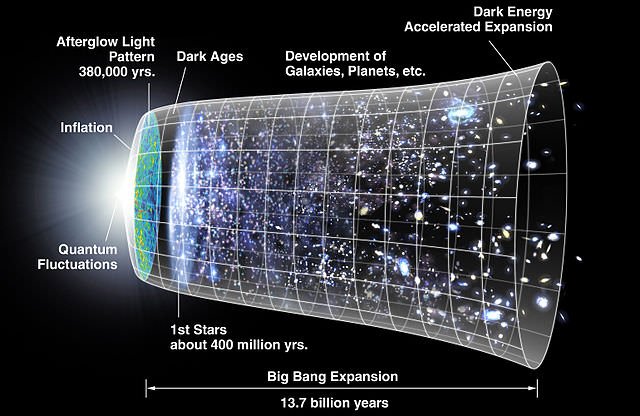
Big Bang timeline
But at least five paradoxes sprung from this line of theoretical unification:
How do we model time at the boundary before the Big Bang. Hawking proposed that there’s no boundary because nothing is measurable before that inception time (when time and space weren’t even yet related). Yet that’s the same as saying time isn’t universal, so it must create another paradox.
Because this “no boundary” model with cosmic inflation gives rise to infinite many parallel universes, Tia Ghose wrote “no one would be able to make any testable predictions about the particular universe we happen to live in”. But presuming all the universes don’t live our emergent (i.e. non-quantum features) physical space (aka the “many worlds” theory of quantum mechanics), falsifiable predictions remain in a probabilistic space which possibly unifies quantum mechanics with the inflationary multiverse. Yet a purely information-based (i.e. intangible) existence seems to not prevent overlapping bounded emergent dimensional spaces because I explained the observers of shared realities don’t necessarily share what they observe symmetrically thus any observer can create a link between sets of shared realities causing them to overlap. Thus preventing overlap would require a total order. So in such an intangible existence, falsifiable science appears to be dead.
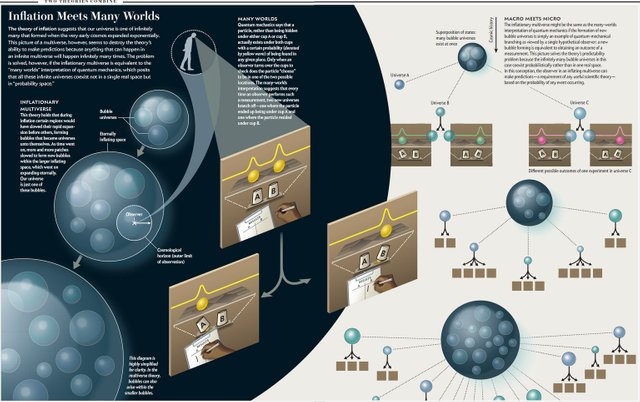
Many-worlds unified with Big Bang cosmic inflationHawking showed that black holes emit radiation which isn’t conserved. This paradoxical information loss was never accounted for.

Hawking radiationThe “no boundary” theory seems to require a negentropic universe (i.e. wherein the entropy trends to minimum and normal distributions are U-shaped intead of bell curves).
The laws of physics in Einstein’s theory are broken at the limit of infinity of the singularity. The black box hidden variables attempt to explain “spooky action at a distance” for unification of quantum mechanics and general relativity was dubious from inception and even until recently continues to appear to be flawed. Tangentially, China is advancing the applied state-of-the-art of this quantum communication, but that’s not relevant to this inconsistency in the General Relativity theory.
We need a simplifying theory. A self-scaling (aka scale-free4) fractal model (← @anonymous is me) seems most intuitive because I previously mentioned phenomenon that may appear to be negentropic at some scale, are in an entropic model at an encompassing scale:
[…] complexity theorists looked at real-world networks and found that they frequently evolve towards a topology that is self-scaling or fractal – clusters of clusters at any scale you examine. Circulatory systems in the body, neural networks in the brain, road and rail networks in human cities, the Internet itself – over and over, we find self-scaling nets anywhere evolution is trying to solve optimal-routing problems.
My thought is the information loss of the black hole is conserved through the singularity to a new universe, i.e. I posit that there’s an inverse singularity Big Bang for every singularity in a black hole. <joke>There’s a complementary maxim, “ideas are like b-holes, everybody has them.”</joke>
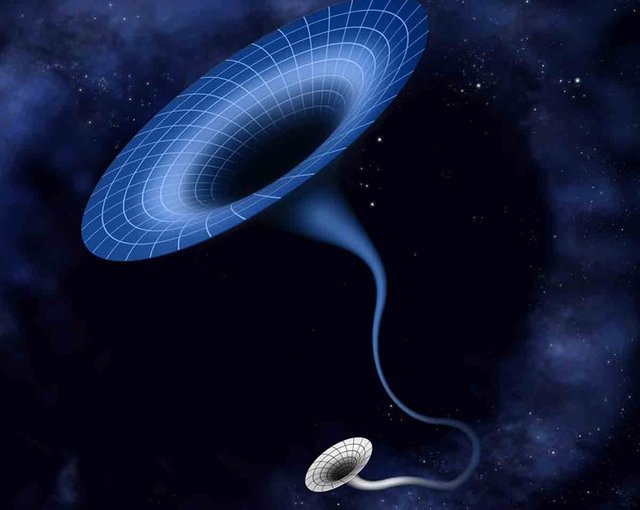
Wormholes, also called Einstein-Rosen Bridges
The inside of each black hole isn’t directly observable because it’s an inconsistent reality (consistent decoherence not possible between the two universes or worlds). This insures the overlap of #2 doesn’t exist in the context of direct perception of the inside of black holes, even without requiring a total order to insure it, because the directly observable inside of a black hole is by definition not coherent (with what’s observable outside). Afaics this would be consistent with a many-worlds quantum mechanics even if not unified with an inflationary multiverse. So a black hole is what appears to be disorder from one perspective, that is order from another, e.g. when conflicting accounts of some event exist the event is disordered from the perspective of an observer who must treat either account as equally probable. I will posit that we have informational black holes which are observed as inexplicable chaos and inconsistency such instances of Murphy’s Law. These arise when information is inconsistent.
Thus the infinitely many-worlds theory seems to resolve those paradoxes whilst slaying the absoluteness of time and falsifiability. There’s even plausible evidence but it can never be definitive because the theories (c.f. also) for multiverse or parallel worlds don’t make predictions that can be falsified (yet they may resolve inconsistencies in preexisting theories whilst not being disproven):
Specifically, they argue that if some scientific theory X has enough experimental support for us to take it seriously, then we must take seriously also all its predictions Y, even if these predictions are themselves untestable (involving parallel universes, for example).
[…] Einstein’s theory of General Relativity […] has made countless correct predictions - from the gravitational bending of light to the time dilation measured by our GPS phones.

Science is dead. Nietzsche’s “God is dead” is dead if humans become rationally informed about righteous idealism in an information age paradigm which may subsume the power-law distribution.
Thus, our memories of temporal orderings of occurrences are merely a partial order which we perceive that we’ve participated in, but which is an illusion of total order. So we may wish to affirm that specific memory of our existence by maximizing the set of concurring witnesses. Our desire for exaltation might be interpreted as a desire for witnesses who are less likely to equivocate due to some naturally occurring conflict of partial orderings in their memory. At the human scale on earth, temporal orderings aren’t usually subject to speed-of-light information traversal ambiguity. For example, in Schrödinger’s Cat thought experiment the quantum decoherence wave function collapse occurs in time epsilon within our shared perspective of the reality of classical mechanics (i.e. non-quantum scale objects) here on earth:
The question Eric was really getting at is this: If “observation” is some mystically special moment not captured in wave-function interactions, we’re not doing science any more but miracles; we might as well collapse into an occasionalist theology in which God makes every sparrow fall by observing its wave function. Game over.
To be doing science – that is to construct confirmable causal accounts with predictive value – we must assume that “observation” is not special. But under this assumption, Eric sees no reason to believe that “mixed states” (e.g. quantum superpositions of multiple classical states) ever persist for more than time epsilon even in small ensembles of particles. Even Schrödinger’s bacterium would be way too large to ever be in a mixed state, let alone his cat!
But it’s incorrect to not state (and insinuate “indifferent” to) that decoherence entirely depends on concurrence among observers of the shared environment:
That phrase “indifferent to the environmental basis chosen” means, exactly, that it doesn’t matter whether you choose an account in which the walls of the box observe the cat or in which the cat’s hindquarters observe the cat’s forequarters; the off-diagonal elements of the matrix still vanish rapidly, the mixed state doesn’t last for more than time epsilon.
This is because the concurrence assumption doesn’t necessary hold for perception of the state of intangible information. Even without quantum superposition, we do experience conflicting transfer of information such as conflicting accounts of events, which is why we attempt to triangulate.
Tangentially I offer a refutation of the Boltzmann Brains paradox as it was explained by Feynman. The consistent decoherence for our shared reality which implies irreversibility of time (i.e. that we all have a consistent ordering of the decohered events) doesn’t refute that our shared reality (i.e. our universe) could be just a statistical fluke in infinitely many-worlds, because the fact that we can see order everywhere we look in our universe doesn’t require the other unobservable (!) infinitely many-worlds to be consistently ordered. By definition of parallel universes that don’t exist in the same emergent space, we never observe the other infinitely many-worlds otherwise our mutually observed decoherence wouldn’t be consistent.
But at large time scales due to the aforementioned arbitrary choice of reference point for triangulation or in a purely intangible informational existence where infinitely many copies of information can be slightly varied, there’s no extant objective distinction (via a non-arbitrary reference point) between multiple realities. Fiction becomes fact. Fact becomes fiction. Science becomes limiting:
Nash suggested his
delusional[imaginative] thinking was […] his characteristic way of thinking, saying, “I wouldn't have had good scientific ideas if I had thought more normally.” […] Only gradually on his own did he “intellectually reject” some of the “delusionally influenced” and “politically oriented” thinking as a waste of effort. By 1995, however, even though he was “thinking rationally again in the style that is characteristic of scientists,” he said he felt more limited.
Folks, we’ve entered the Twilight Zone.

Consciousness might be concurrence of observers w.r.t. an emergent real space. I return to the concept I postulated in 2013 and expounded upon in an evolutionary context, that we can only exist because of friction. Information is unbounded so we exist due to our finite capability to observe and assimilate information:
Although it’s a standard assumption in physics that physical space is continuous, with even the smallest volume containing infinitely many points, it’s an Achilles heal in the sense that we have no experimental evidence for anything truly continuous or infinite in nature.
This enables conflicting partial orders. Otherwise information couldn’t exist because it would be infinitely disordered. Information is unbounded in extent or quantity, yet necessarily quantized in observable instances. This is analogous to necessary asymmetry (for example interpreted in spacetime as irreversibility) provided in my aforementioned refutation of the Boltzmann Brains paradox. An analogous refutation would logically apply to the recent CERN discovery that our universe shouldn’t exist. In our universe we have for example one proposed emergent model of friction as spacetime with a bounded, quantized speed-of-light. However, I think the currently accepted models are too limited to fully describe the capability of our brains in the intangible information age.

P.S. Combined with this and the above, my layman’s intuitions in 2013 seem to have been in a fruitful direction. I’m also interested in the harmonic analysis of mathematical structure.
4 I applaud Rifkin’s explanation up until the point in his presentation where he spirals off into ressentiment-based social justice FUD. Net neutrality is an inane argument for more of the regulation which enables the telcoms’ monopolistic pricing power. That metered pricing power is uneconomic in a free market. Regulation makes net neutrality regulation necessary. The dog is chasing his tail. If scratching your eyeball hurts, gouging it out won’t hurt less. Telcoms aggregate size (i.e. increase market centralization) to relatively minimize their management costs because of reasons which at the generative essence are the efficiencies from economies-of-scale of providing a fungible commodity network (as opposed to a non-fungible network) and inability to extract high profit margin in a fungible commodity market. The free market solution is the commodity price is set by the highest marginal cost producer. Currently there’s no IOT-like free market where anyone can put up a wireless tower and offer it in the grid with a commodity market-based pricing. The solution is for the government to get out of the way of competitors so such a commodity market system can develop.
Peer-to-peer fully connected mesh networks (e.g. as contemplated for smartphones) aren’t economic as an alternative because economic fungible networks have a scale-free structure (i.e. power-law distribution of network links aka graph edges between nodes) for reasons (1, 2, 3) roughly analogous to the prioritization reasons why we multifurcate instead of running a separate water main pipe directly from the pumping station to each household. The Bitcoin network topology is a scale-free example of providing fungible access to all nodes but because of the cost of mining on an old block when a new one has been announced, propagation latency is prioritized by power-law distribution to the greatest portion (i.e. radius) of the hashrate per unit of propagation time. This results in a nearly fully connected mesh for the nodes whose hashrate isn’t insignificant. Thus, a fungible network theory presumes not only that “as link capacity reaches a level the average customer isn’t capable of saturating” but also I add the stipulation that as “average latency of links reaches a level that is tolerable for the average customer” then the fungible model applies. That Bitcoin example is also interesting because it shows how from one perspective (nodes prioritized by hashrate), the network connections are an entropic distribution but when all nodes are considered it’s negentropic scale-free power-law distributed.
Disclaimer: this compendium is a rushed attempt to synthesize a holistic analysis of human history incorporating theology, abstract math, and to some extent the scientific method. Due to the lack of available time to apply to this extremely ambitious and complex endeavor, this is a work in progress which is subject to change as I become aware of new facts and facets of analysis. I’ve tried to contemplate falsification, alternative explanations, and the predictive value of the theories discussed. Yet I’m aware I didn’t have sufficient time, energy, health, youthfulness, and reflection time to do this exhaustively and systematically. Rather than seek perfection before publishing, open source theory of maximizing trade within the inverse commons, instructs me to publish early, publish often, and iterate.
All the links in this blog has been archived at archive.is and/or archive.org.
Einstein noted this in travel diary.
Europeans driven to cooperation (i.e. defeat of clans/tribes and adoption of manoralism) and technological innovation by continuing adversity of plagues and attempted invasions from the more populated East.
Note also the linked blog’s claim that Europeans originated from the original Steppe people who had domesticated horses for travel. This seems to correlate well with the European leap forward due to both manoralism and the use of arable land for work and travel horses instead of for feed and animals fed for edible consumption as I discussed in my blog being the great bifurcation of the West and East. With the East, going for higher population density and lower network effects.
Someone pointed out to me that I employed poor wording. Obviously from the context, I mean that normal distributions are never U-shaped. My point is obviously that a U-shaped distribution is negentropic. I also failed to note that another potential way that could become entropic is if the left tail perishes and then a normal distribution obviously exists within the right tail although that might not be stable.
That individual also reminded me that the discrete uniform distribution has the highest entropy of any distribution with finite support. I pointed out to him that the entropy of the discrete uniform distribution is the uniform level of uncertainty over which individual of the population will have the uniform trait. So it’s negentropic from the standpoint of uniform traits, although maximally entropic in terms of the uniform distribution of probability of having that uniform trait. The normal distribution is entropic from the standpoint of non-uniform traits, as well as each individual having an uncertain (but not maximally entropic, i.e. uniform) probability of having a specific trait. Yet clearly the normal distribution is more entropic because there’s a multi-dimensional partitioning of the possibilities, i.e. the uncertainty is greater and more distributed. IOW, the true entropy of the normal distribution when comparing it to the discrete uniform distribution must also be multiplied by the entropy due to the uncertainty of each individual in the population having each particular trait embodied in the normal distribution. Wikipedia doesn’t make this clear.
Also note that any increase in order must be increasing disorder overall (c.f. the bottom of the linked post).
Also I wrote:
I followed up with a post on Quora (see the latter half of the post):
https://www.quora.com/Do-advances-in-AI-mean-that-before-long-we-won-t-need-computer-programmers-as-we-ll-be-able-to-just-ask-a-computer-to-write-me-some-code-that-does-the-following/answer/Shelby-Moore-III
Anonym
https://medium.com/starts-with-a-bang/the-big-bang-wasnt-the-beginning-after-all-81844b973333
@CoinCube expounded on the theories of our universe which relate to the (meta)physics I discussed in §Overcoming the Power-law Distribution of my blog above.
Since the mods at
bitcointalk.org(aka “BCT”) are prone to delete posts anytime and that database is closed source and could disappear someday, I have archived the linked post here and here.Someone commented to me in private that the Second Law of Thermodynamics only applies to closed systems. I pointed out that the implication applies to universal trend.
If universal entropy did not trend to maximum, then it would mean that there’s a possibility for thermodynamic systems to be reversible, but that would require that time doesn’t exist and the past and future are indistinguishable. See also: https://steemit.com/science/@anonymint/the-golden-knowledge-age-is-rising
If universal entropy did not trend to maximum, then it would mean that there’s a possibility for thermodynamic systems to be reversible, but that would require that time doesn’t exist and the past and future are indistinguishable. See also: https://steemit.com/science/@anonymint/the-golden-knowledge-age-is-rising
Excellent comment by @h0bby1 which he wrote one of my other blogs, also applies very much to this blog. Highly recommended to click that link and read his comment.
There’s no total orders in math:
https://github.com/keean/zenscript/issues/8#issuecomment-417968131
Physicalism Implies Experience Never Dies is writing about what I wrote about the multiverse on this blog.
We can’t remember this world in our multiversal existence. So his clickbait is not as neato as he leads on, yet I like his detailed exposition.
A very curious read, some parts of it suggest similarities to the "impossible" Awareness singularity phenomenon I mentioned in BitcoinTalk messaging with you, if you recall.
There's something quite peculiar going on regarding this subject, though trying to specify anything about it is on shakey ground. And of questionable utility.
But ultimately without whatever "it" is, everything would be for nought, we would be nothing more than wonderfully intelligent, self aware, self inquiring, self feeling, emotional clockwork, with no "one" truly experiencing anything through us.
I can easily imagine whole universes just like ours, Identical in every other imaginable way, but no one actually experiencing any of those lives, a whole universe being that tree that falls in the woods without anyone hearing it.
Personally, I'm content with it simply existing and being it, trying to study it using the machinery of our minds, or anything in the universe seems akin to trying to pick a single molecule of gas out of the atmosphere using boxing gloves, grossly unsuitable. Nothing we have in the universe is even remotely suitable for the task.
It's paradoxical that its existence is even discoverable in universe, because it "Should" have NO effect on the universe where it is being thought about, so I'm likely to be quite wrong in part, or completely. Something is wrong somewhere.
So. Probably best to simply appreciate being it. And turn one's study to everything else in the universe where one might actually make some in-universe progress, making existence better for it/us through bettering ourselves in areas we can actually understand and benefit from no?
I wrote on Quora in response to a question and a theory about what it the fundamental unit of existence at the smallest-scale: